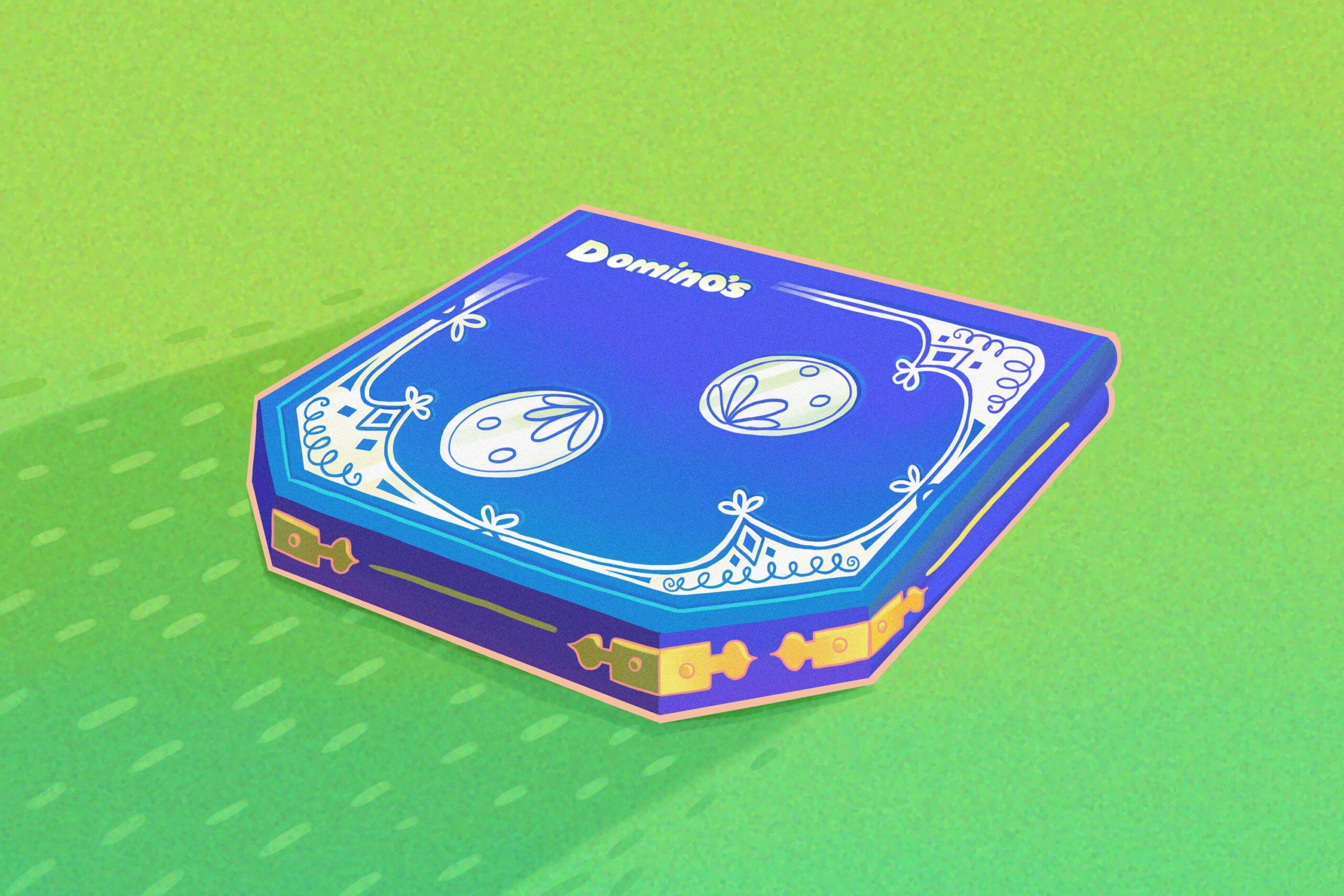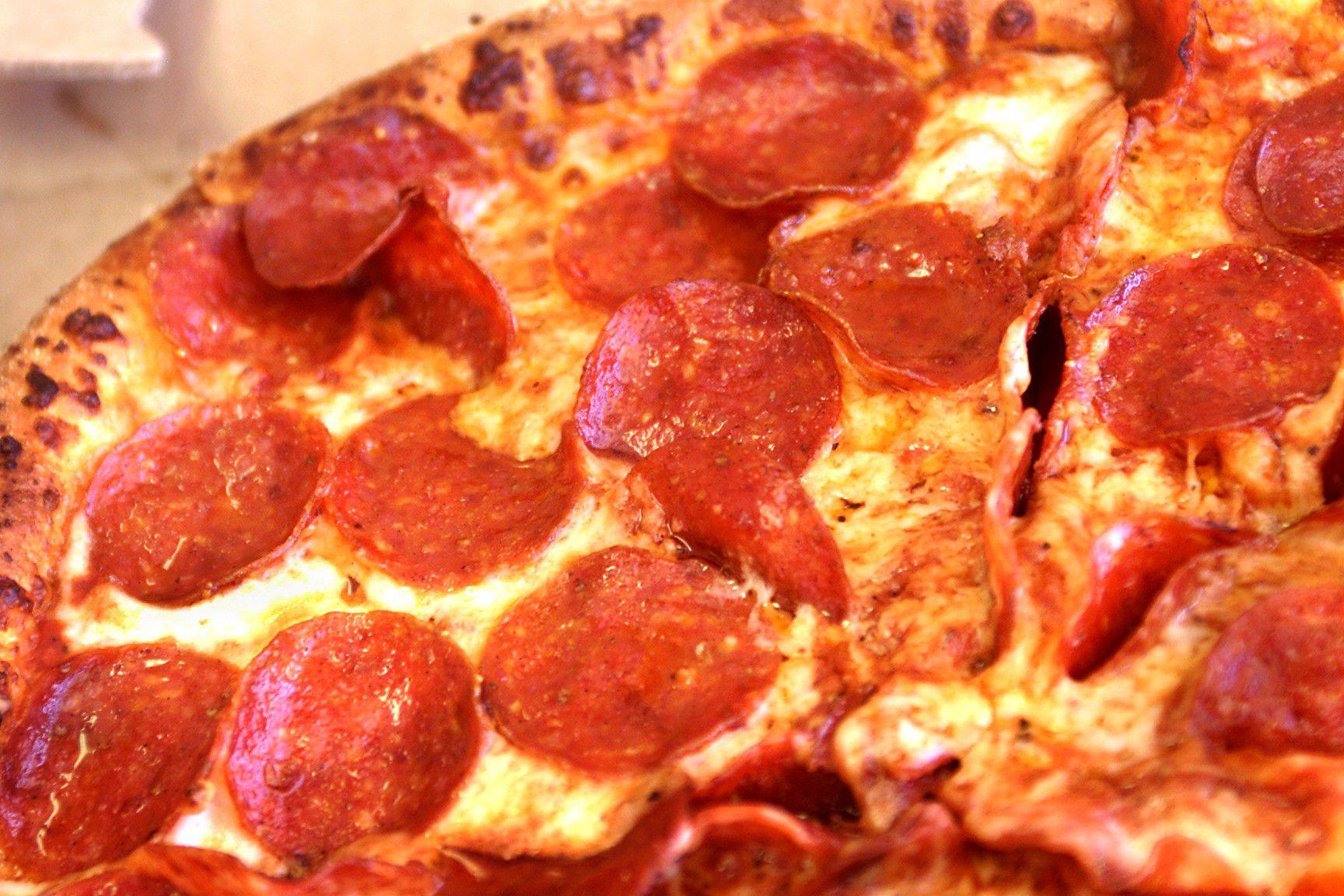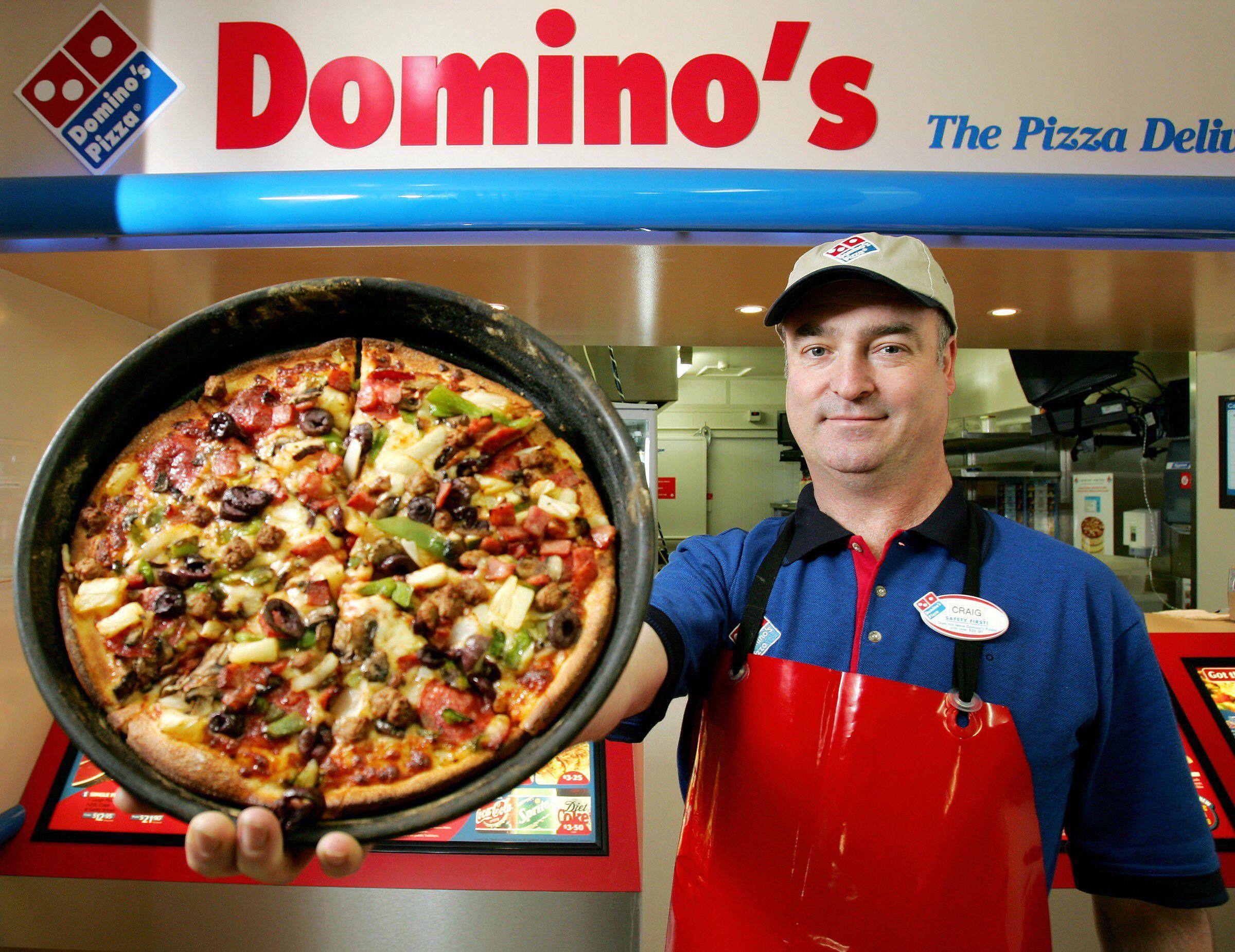How Domino’s Became the Pizza for the People
The chain tweaked its recipe and worked its way back into customers’ hearts to create an army of devoted fans
The act of ordering Domino’s can be described only as a sublime experience. I open my computer and hit the bookmark that takes me to the sleek homepage. I log in to my personal pizza profile, and, with just one click, I pay for my pepperoni pan pizza with extra sauce, baked, well done. Then I sit back, watch the online tracker, and think of nothing else as it broadcasts the updates: Isabel puts my pizza in the oven. Darien executes the quality check. Moe carries it to the car and brings it to me. Then the real experience begins.
My two hands grab the box and open it hastily. Gratification is near. The cheese and swirls of sauce threaten to drip over the edge of the thick, buttery crust. I take a bite before it cools. The rush of fat and oil and robust tomato sauce and butter hit my tongue and light up my pleasure centers. Another bite. Another slice. A whole pie. Domino’s satisfies in a way nothing else can. Tell me, when’s the last time a Papa John’s pizza ever did that for you?
I’m firmly in Domino’s target demographic, if not a dream user. I ordered from the chain all the time as a college student, and following a brief separation, I continue to order Domino’s even though I’m an adult with a working knowledge of nutrition and a tendency toward heartburn. I ride for Domino’s like Jay Z rides for Beyoncé.
As recently as 2015, when Jets player Bryce Petty was shamed for admitting on Twitter that he was a Domino’s fan, everything I just confessed would have been met with a massive eye roll. There was a certain face everyone made (pity? revulsion?) and a thing that everyone said when I suggested we order from the chain on Bachelor nights: “But you live in New York.”
Yes, I do, but it doesn’t matter. Domino’s might not be Lombardi’s, but after a series of events, it’s time to consider Domino’s a pizza worth loving. In 2009, the company reinvented its sauce, among other sweeping improvements. In 2014, it won an Epicurious taste test. Earlier this month, Drake ordered £1,500 of Domino’s after a show in London; it took three cars to deliver it. And last year — I’m not being hyperbolic — a Domino’s fan literally saved lives.
Ruby Tandoh, 2013 Great British Bake Off contestant and cookbook author, agrees. “I’m not a legit Domino’s connoisseur but I’ve liked it every time I’ve had it,” she says. “I can say with pretty much complete certainty that part of the reason for this is because it is the anti-pizza. It’s the anti-artisanal, anti-natural, anti-handmade, anti-thin crust pizza. It’s … the pizza emoji pizza. I love it.”
Even “real New Yorkers” are believers. Manhattan-based lawyer in the food and drink industry Jasmine Moy ordered Domino’s for the first time four months ago and was an immediate fan. “Listen, I’m a New Yorker, I know pizza. But I will say that pan pizza showed up and I thought it was not awful. I actually sort of liked it. Now I have a craving for it. The bread dough is almost like a focaccia … it’s crispy and it’s oily and it’s pretty delicious.” Now she and her boyfriend order a Supreme Pan Pizza with jalapeños every other week. He is a “Domino’s freak,” she says, and she’s becoming one too.
Thanks to unofficial celebrity endorsements from Allison Williams and Nigella Lawson and changes to its recipes, nobody needs to be ashamed of their fervent love (or even casual tolerance) for Domino’s pizza. Armed with the signature pan pizza and stock currently trading at $186 per share, the chain has earned enough fans that all who order no longer need to call it a guilty pleasure. It’s just a pleasure. And the fans are more like fanatics.

I am the first to admit that there’s a part of being a Domino’s enthusiast that is painful. It makes you feel a little terrible inside. I’m not talking about psychologically; it’s like your organs are protesting. Maybe that’s why Domino’s has made it its mission in the past six or seven years to shamelessly pander to fans (or maybe because it’s really profitable). Regardless of motive, Domino’s major innovations since 2009 have not only increased sales, but they’ve also inspired fanaticism and viral discussion of the brand — except for maybe the introduction of salad. “There have been some misses,” admits chief marketing officer Joe Jordan.
In 2008, sales were at an all-time low. Its stock was worth $4 a share. A national taste test indicated that consumers considered it on par with Chuck E. Cheese’s in terms of taste. That’s dark. Sure, you could get it fast; the company was still well known for its 30-minutes-or-less guarantee. But what good was fast delivery if the crust tasted like cardboard and the sauce tasted like ketchup, as focus groups reported? (Let me ask you that again when you’re stoned.) Domino’s knew its pizza was bad, and this is where the brand’s revival story began.
The company made a few key changes starting in 2008. First, it released the Pizza Tracker, which gamified pizza ordering and, according to an unofficial poll I conducted, is the most beloved part of the Domino’s experience. (Moy, her boyfriend, and even a friend who doesn’t really like Domino’s agree on that.) It also set Domino’s up as the most technologically advanced pizza chain, a spirit that it’s continued by allowing people to order by emoji, working with Samsung to allow voice-ordering through smart TVs, and introducing drone deliveries in New Zealand.
The following year, the company launched its “new and inspired” pizza, a recipe that required 18 months and millions of dollars to perfect: 100 percent real mozzarella, flavored with a hint of provolone; a sweeter, bolder tomato sauce with herbs and red pepper; and a garlic-seasoned crust with parsley baked in.
But changing the pizza wasn’t enough. The company wanted to inspire people to return to the brand.

Domino’s used to have a name for these customers they were targeting. “We used to call them boomerangs,” explains Jordan (his go-to order: Brooklyn crust, grilled chicken, diced tomatoes, and green olives). “These were consumers who may have enjoyed us back in college or when they were younger, when we really did have that differentiating factor — we delivered fast, we had a good value, and we filled a role for them at that point in their lives. But, over time, they grew up, their palates evolved, they lost engagement with the brand.”
So the company spent $75 million on a campaign to tell everyone, “Hey guys, we’ve been screwing up for a while now. We made bad pizza, but now we make good pizza. Please buy it!” The spots, as you might remember, featured CEO Patrick Doyle and pizza chefs begging consumers to give them a second chance, while acknowledging all the complaints they’d heard over the years. It was so self-deprecating it had to work.
“Growing up, I didn’t like Domino’s. Then they had a revamp, and I feel like when they introduced the Pan Pizza [in 2012], I really started liking Domino’s again,” says Kelly Dobkin, a senior editor at Zagat (Pan Pizza, half plain, half mushrooms and green peppers). The Handmade Pan Pizza is a deep-dish pizza that took three years to develop. There are two layers of cheese. The dough is fresh instead of frozen. It takes longer to bake, so farewell, 30 minutes or less, but it arrives in a sleek black box, the caloric equivalent of a Black Amex, and feels distinctly designed for the eating of feelings.
“I do appreciate the fact that when they relaunched they were really honest about the fact that their old pizza sucked. ‘We realized our pizza really wasn’t that good.’ That would be great if everyone took responsibility for making mistakes,” Dobkin says. “It was a solid campaign. People appreciate honesty.”
It’s true. People make mistakes. We should all aspire to have the humility as Domino’s, no? “Oh, come on,” snorted a friend of mine when I was explaining the brilliance of this campaign. “If you could make better pizza this whole time, why wouldn’t you? It’s like you’ve been making it for decades and now you care? I appreciate your honesty, but it doesn’t make me want to eat your pizza.” Where I was inspired, he was indignant.
But Domino’s saw people like my offended friend coming. “We knew this campaign was a risk,” says Jordan. “We knew people might say, ‘We’re really sorry, you kind of blew it.’ But [the old pizza] didn’t create any brand love. It didn’t create the ambassadors, the superfans that we love to have now.”
But fans came back, hence the name “boomerangs.” Domino’s marketing department tracks them through sales numbers, noting who orders regularly. Now they make up a diverse body of users who order Domino’s across a variety of known pizza occasions, Jordan tells me.
“It’s Monday night and I’ve gotta go pick up the kids, or I’m on my way home from work and this is a simple solution for me to grab a pizza … or a birthday party, or it’s the Sunday-afternoon football party and I’ve got all these different specialty pizzas and I know I can please everyone,” says Jordan. He left out “I’m a drunk adult and it’s 2 a.m.,” but it’s obvious how important that pizza occasion is, too.
Among those customers, Jordan’s team has identified a group of “heavy users,” people who notably order a lot of pizza frequently. “Wait. Would I be one?” I ask him during our phone conversation.
“Well, what, are you ordering, say, once a month?”
“Oh, like, three to four.”
“Oh, OK, definitely.”
I am not ashamed. I am proud.
From those heavy users, Domino’s has picked out superfans, a designation that is harder to define. “[They’re] the ones that we joke have “sauce in their veins,” says director of loyalty marketing Stephen Kennedy, who favors Buffalo chicken pizza on a hand-tossed crust.
The Domino’s superfans are a little bit famous right now. Many of them — the ones who had Noid tattoos (the brand’s mascot from the 1980s), used Dom’s pizzas for promposals, dressed up as Domino’s pizza for Halloween — were featured in an ad that premiered in early December.
But it’s hard to say exactly what makes a superfan. They’re not merely defined by how many pizzas they order in a month. For example, there’s Annie, 70, who has ordered a Domino’s pizza once a month for as long as she can remember, says Tony Calcao, the EVP executive creative director of Crispin Porter + Bogusky, tells me. Calcao (Pan Pizza, spinach, mushrooms) and his team have spent hours speaking to superfans trying to figure it out. His advertising firm was responsible for vetting all of the superfans for the commercial, which meant spending hours on the phone really interrogating people’s love of the Dom.
“It was just being a fan and showing this crazy love affair with the brand,” Calcao says. “Who is crazy enough to be posting about Domino’s, taking pictures of Domino’s, and whatnot? We felt that if you were in love with the brand enough to wear a Domino’s costume on Halloween or dress up your dog as a Domino’s delivery guy or get a tattoo of our logo, then you must be a Domino’s superfan. It was not hard to find people that had this love and devotion to Domino’s. There were a lot of tattoos.”
They were looking for those special people who not only ate pizza, but who were willing to act as ambassadors, apostles even, spreading the gospel of Domino’s all over the land.
Los Angeles–based tattoo and graffiti artist Philip Figueroa, 32, is one of them. He’s been eating there since he was a kid in the late ’80s (his go-to: pepperoni and jalapeño on a thin crust), when he considered the Noid as legendary a cartoon character as Garfield. As an adult he’s dedicated nearly 200 hours to building shrines to Domino’s Pizza — a Stormtrooper costume made from pizza boxes, a Darth Vader costume made from those famous black Pan Pizza boxes, and a knight’s costume that took him more than 70 hours to build. That one is, iconically, featured in the superfan commercial Domino’s aired.
The reasons he loves the chain are pretty simple: “It’s an efficient product, you know. It tastes good.” Though even Figueroa admits Domino’s sucked for a time. He’s much happier with the taste now. “That pizza is like night and day now,” he says. “I’m a full-time mom and dad. I can get a pizza for $5.99 and feed my family. Everything is so greedy now. I’m going to support [Domino’s over] the company that isn’t for the person or the people. I like Domino’s attitude.”

But, as Jordan and Kennedy know, Figueroa’s loyalty comes from a surprisingly emotional attachment to the brand.
Figueroa first made his Stormtrooper costume for an art class. Domino’s contacted him after he posted an Instagram of it, and the company bought both the Stormtrooper and Darth Vader immediately. When it came time to shoot the commercial, Jordan and his team reached back out to Figueroa and asked him to make the knight costume. Due to copyright issues, the company couldn’t feature Star Wars properties. Figueroa worked for a week straight to complete it. “I had no idea it was going to touch people the way it did,” he says. “Kids love it. Adults love it. They geek out.”
All of his costumes, Vader and Stormtrooper included, are now on display at Domino’s Ann Arbor, Michigan, headquarters. “Oh man,” Figueroa tells me. “When I saw that on display, it hit me in the gut. I thought it was ruined. When I filmed the commercial, it was so hot out here I totally sweated that out. I didn’t think I was ever going to see [the costume] again. I’d worked so hard on it, it was like being separated from my family. But they saved it, they put it back together even though it was soggy.”
And that’s where the emotional attachment comes in. As ride-or-die as Figueroa is for Domino’s, he feels like the brand reciprocates.
“When this world is being so ugly and so greedy, and their thoughts and their process is all about giving back to the people on the lower end, or really caring about their fans and franchisees — I just really like that,” Figueroa says. “They have done nothing but good for me. I really appreciate what they do. They have never turned me down for anything. Those are the people you want on your side.”
“Did you get a lifetime supply of pizza after the commercial?” I ask.
“Well, no,” he says. “It’s not like [Happy Gilmore] and the Subway card, but I know I could always call them for some pies.”

A cynic might point to junk food addiction to explain what might otherwise be called brand loyalty. In his book, Why Humans Like Junk Food, food scientist Steven Witherly explains why we like pizza in the chapter titled, “Why We Like Pizza.” He writes, “The simple contrast of a harder exterior and a softer interior loaded with taste-active solutes and ingredients is one of the most fundamental aspects of good food construction.” (Cheese and sauce on bread is good.) He also points to the addictive quality of a food with such “texture contrast” and the crack-like properties of wheat and cheese that light up our dopamine centers and make us want more. (Pizza is addictive.) The variety of pizzas you can order allows for hedonic optimization. (You can eat a lot of it.) Basically, pizza is engineered to be loved a lot.
But maybe there’s more to love. Just maybe.
This month the company announced an actual Domino’s Wedding Registry. “That was a no-brainer. We spoke to some customers that were having a reception somewhere remote, and the caterer screwed up somehow, and now there is no food for the guests. The groom was a fan of Domino’s, and they showed up in 30 minutes with a whole lot of pizza. Also, let’s face it. Who wants a gravy boat these days?” Calcao says of how the registry came to be.
People actually registered, though the team doubts it’ll make a huge amount of money from the stunt. That’s not the point. The company wants fans to know that Domino’s Pizza is there for them at every stage of their life, at every milestone. Frankly, if the company could get an auto-alert for my death and deliver to my funeral, I’d sign up for it.
Even if customers prefer a more traditional wedding, they can still enjoy other Domino’s incentives. Members of the loyalty program can become actual stock owners through the Piece of the Pie rewards program. Each month, 25 members are randomly chosen to receive 10 shares of stock in the company.
“We’re going to reward you for just being a great fan of Domino’s,” says Kennedy. “Nothing more than that.”
And isn’t that real love? To see and be seen? To Domino’s, this level of fandom is more than just how many pizzas someone orders, it’s something spiritual, almost. It sees that the sauce in your veins matches the sauce in its veins. Perhaps that’s what really inspires a legion of superfans, the knowledge that the company is made up of pizza freaks just like them … or maybe it really is just the Pan Pizza.